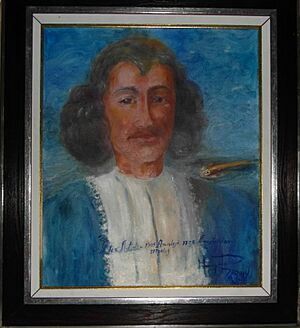Peter Artedi facts for kids
Quick facts for kids
Peter Artedi
|
|
|---|---|

Peter Artedi, a painting by the artist Mary Pinzón, showing how he might have looked
|
|
| Born |
Peter Artedi
27 February 1705 Anundsjö, Ångermanland, Sweden
|
| Died | 28 September 1735 (aged 30) Amsterdam
|
| Nationality | Swedish |
| Education | Uppsala University |
| Known for | Pioneer ichthyologist |
| Scientific career | |
| Patrons | Albertus Seba |
| Author abbrev. (zoology) | Artedi, Arctaedius, Art. |
Peter Artedi (born February 27, 1705 – died September 28, 1735) was a Swedish naturalist. He is often called the "father of ichthyology". Ichthyology is the scientific study of fish. Artedi made huge contributions to how we understand and classify fish today.
Contents
Who Was Peter Artedi?
Peter Artedi was born in a place called Anundsjö in Sweden. When he was young, he planned to become a clergyman, which is a religious leader. He went to Uppsala University in 1724 to study theology. But soon, his interests changed. He became very interested in medicine and the study of nature. He especially loved learning about fish.
A Friendship with Linnaeus
In 1728, another famous Swedish scientist, Carl Linnaeus, came to Uppsala. Linnaeus is known for creating the system we use to name living things. Peter Artedi and Carl Linnaeus became very good friends in 1729. They shared a strong passion for nature.
Before they went on separate journeys in 1732, they made a special promise. They agreed that if one of them died, the other would finish their scientific work. This promise would later become very important.
Adventures and Discoveries
In 1734, Artedi traveled to England. He even saw a whale in London! In the summer of 1735, he met Linnaeus again in Leiden, a city in the Netherlands. Artedi was low on money at the time. Linnaeus introduced him to a rich Dutchman named Albertus Seba. Seba had one of the biggest collections of natural objects in Amsterdam.
Seba hired Artedi to write descriptions of the many fish in his collection. This was a big and important job for Artedi.
A Sad Ending
Sadly, Peter Artedi's life ended too soon. On the night of September 27, 1735, he was walking home from Seba's house. He accidentally fell into a canal and drowned. His body was found the next day.
When Linnaeus heard the sad news, he rushed to Amsterdam. Remembering their promise, Linnaeus took all of Artedi's notes and writings. He worked hard to finish Artedi's books about fish. In 1738, Linnaeus published Artedi's work. The book was called Ichthyologia sive opera omnia de piscibus. It included Artedi's detailed descriptions and ideas about fish.
Remembering Peter Artedi
Peter Artedi was buried in a simple grave in Amsterdam. His grave was never marked, and the area is now used for other things. However, people still remember him.
A famous epitaph (a short text honoring a dead person) was written for him. It was written by another scientist, Anders Celsius, and translated by George Shaw:
Here lies poor Artedi, in foreign land pyx'd
Not a man nor a fish, but something betwixt,
Not a man, for his life among fishes he past,
Not a fish, for he perished by water at last.
This poem means that Artedi spent his life studying fish, almost like he was one of them. But in the end, water, which is where fish live, caused his death.
Many years later, in 1905, a memorial stone was put up for Peter Artedi in the Amsterdam Zoological Gardens. There are also other memorial stones in Sweden, in his home areas of Anundsjö and Nordmaling.
Carl Linnaeus also honored his friend by naming a plant after him. The plant is called Artedia. It's a type of plant found in the eastern Mediterranean region.

